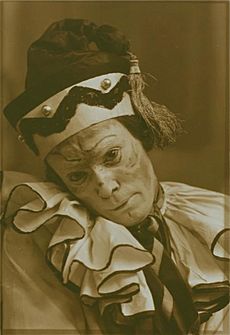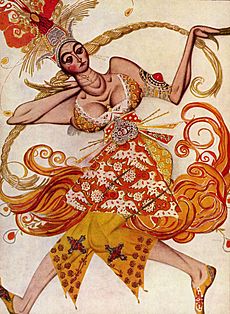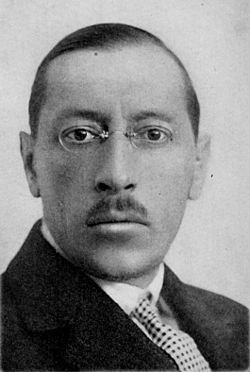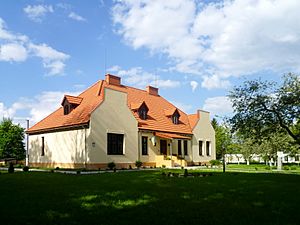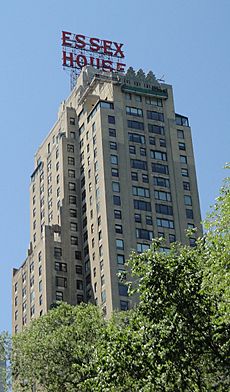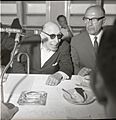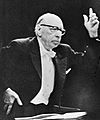Igor Stravinsky facts for kids
Igor Stravinsky was a very important composer of the 20th century. He was born in Lomonosov, Russia, on June 17, 1882. He passed away in New York on April 6, 1971. Stravinsky was a leader in new and modern music.
He grew up in Russia. When the Russian Revolution began, he moved to Switzerland. Later, he moved to Paris. Finally, when World War II started in 1939, he moved to the United States.
Stravinsky wrote music in many different styles. At first, his music was similar to his teacher, Nikolai Rimsky-Korsakov. He loved Russian folk music. He wrote lively music with complex chords and rhythms. Some of his most famous works were for the Ballets Russes. This was a famous ballet company led by Sergei Diaghilev. These works included The Firebird, Petrushka, and The Rite of Spring. He wrote these between 1910 and 1928.
Later, Stravinsky changed his style. He wrote music in a "neo-classical" way. This meant he used ideas from older classical music but gave them a modern twist. His only full-length opera, The Rake's Progress, is an example of this style. In his final years, he explored a style called serial music.
Contents
Early Life and Musical Journey
Igor was the third of four sons. He spent his winters in St. Petersburg and his summers in the countryside. Many of his mother's relatives owned large estates there.
Igor was not a great student at school. However, he often went to the opera house to watch his father, Fyodor, perform. Fyodor was a talented opera singer with a strong bass voice. He sang in Kiev and later at the Mariinsky Theatre in St. Petersburg. Igor also enjoyed ballets. He even heard Tchaikovsky conduct a concert in 1893, shortly before Tchaikovsky's death.
For a while, Stravinsky studied law at St. Petersburg University. But he left in 1906. He then married one of his cousins. They soon had a son and a daughter.
Since his school days, Igor played the piano. He also took lessons in harmony and counterpoint. He loved to improvise music and became interested in composing. He wrote some short piano pieces. He showed them to the famous composer Nikolai Rimsky-Korsakov, who was the father of a friend. Rimsky-Korsakov advised him to continue with private music lessons. He thought this was better than going to a conservatory.
Soon after, Stravinsky's father died. Igor went to stay with Rimsky-Korsakov. There, he met many musicians. Rimsky-Korsakov taught him how to write music for different instruments. From 1905 until Rimsky-Korsakov's death in 1908, Stravinsky had private lessons twice a week. He thought of Rimsky-Korsakov as a second father.
Rise to Fame
After Rimsky-Korsakov died in 1908, Stravinsky met Sergei Diaghilev. Diaghilev was a ballet impresario, meaning he organized and managed performances. He wanted new operas and ballets. He saw that Stravinsky could be the perfect composer.
Diaghilev asked Stravinsky to write music for a ballet called The Firebird. This ballet was based on a Russian fairytale. Stravinsky wrote it at Rimsky-Korsakov’s country house and finished it in St. Petersburg. The Firebird ballet was first performed in Paris on June 25, 1910. It was performed by the Ballets Russes, who were very famous in Europe. Mikhail Fokin was the choreographer. The Firebird became one of Stravinsky’s most famous pieces. Parts of the music are often played in concert halls without the dancing. This is called a “suite”. It shows Stravinsky's love for Russian folk melodies.
The success of The Firebird made Stravinsky famous worldwide. His music became especially well known in Europe, especially in Paris. The Ballets Russes were based there. Stravinsky's next work for them was Petrouchka. It told the story of a puppet that comes to life. It was performed in Paris on June 13, 1911. It became as famous as The Firebird. This music is also often played in concerts. Stravinsky even arranged three of the dances for solo piano. They are very difficult and need a virtuoso pianist to play them.
Stravinsky became well known among other musicians. His friends included Debussy and Ravel. He met Schoenberg in Berlin and was very impressed by his piece Pierrot Lunaire. Stravinsky spent a lot of time with his family in Switzerland. He found peace and quiet there to compose.
On May 29, 1913, a new ballet by Stravinsky called The Rite of Spring was performed in Paris. It caused a huge stir. Some people loved it, while others hated it. There was even a big fight in the theater, and the police had to be called. People were shouting so loudly that no one could hear the music. Stravinsky became ill afterward and needed weeks to recover. When the ballet was performed again, people were quieter and listened. The music had many new ideas: harsh chords and very complex rhythms. The Rite of Spring had a great influence on how music developed in the 20th century.
Stravinsky’s next idea for a ballet was Les noces, which means 'The Wedding' in French. Stravinsky went back to Russia to gather ideas for it. When he returned to Switzerland, World War I began.
Life During the World Wars
Stravinsky’s family stayed mostly in Switzerland during World War I. He had less money because his income from Russian properties stopped. The Ballets Russes could not perform in Paris anymore. Stravinsky spent a lot of time working on Les Noces. He finished it in 1917 and played it for Diaghilev. It took another six years before it was performed. Stravinsky decided to arrange it for four pianos, percussion instruments, a choir, and solo singers. It was performed on June 13, 1923.
Because Switzerland was neutral during the war, Stravinsky could travel. He went to Italy, where he met Gerald Tyrwhitt and Prokofiev. He wrote pieces like Reynard and Rag-Time. He also performed in America with the Ballets Russes.
When the Russian Revolution started in February 1917, Stravinsky thought it would be good. But when the Bolshevik Revolution followed, it became clear he could never go back to Russia. He wrote L’histoire du soldat (The Soldier’s Tale). It was performed in Lausanne. There would have been more shows, but many people got the influenza flu. When the war ended, Stravinsky decided to move to France. He wrote a ballet called Pulcinella, based on music by the 18th-century composer Pergolesi. It was performed in Paris on May 15, 1920. For some years, Igor became interested in 18th-century music. His work after 1920 is often called neoclassical.
Life in France

In 1920, Stravinsky’s family moved to Brittany, France. The next year, they moved to Biarritz. Stravinsky composed Symphonies for Wind Instruments. It was soon performed in London. This concert also included The Rite of Spring. He met a theater designer named Serge Soudeikine and fell in love with Vera, who would later become his second wife. Meanwhile, his first wife, Katerina, was ill with tuberculosis. Vera and Stravinsky saw each other often for the next 18 years.
Stravinsky’s mother managed to leave Russia and joined his family in Biarritz. Stravinsky had a large family to support. He decided to work more as a conductor and pianist instead of composing only large works. He composed smaller pieces, like the piano version of three dances from Petrouchka. Later, he composed a Concerto for two solo pianos for himself and his grown-up son to play together.
He did not compose for the Ballets Russes anymore. However, he did compose Oedipus rex as a special tribute to them. This work was a mix of opera and oratorio. The words were in Latin and written by Jean Cocteau. It was performed as a concert. He also accepted an invitation from Ida Rubinstein to write a ballet called Le baiser de la fée (The fairy’s kiss). This ballet was based on music by Tchaikovsky. Diaghilev was not happy, but he died in 1929, and the Ballets Russes company ended.
In 1926, Stravinsky, who belonged to the Russian Orthodox Church, had a deep religious experience. This affected his music. One of his best religious pieces is the Symphony of Psalms. He wrote it for the Boston Symphony Orchestra’s 50th birthday.
Stravinsky met the violinist Dushkin. He composed a Violin Concerto and the Duo concertante for violin and piano for them to play together. He became more and more popular in the United States. He wrote several works for American people. He was offered a job as a professor at Harvard University. At this time, many of his family members became ill. Then his daughter, his wife, and his mother all passed away. He also became ill himself. By September 1939, just as World War II began, he was well enough to travel to North America.
Life in America
In America, Stravinsky was immediately asked to conduct many concerts. Vera arrived four months later, and they married in Bedford, Massachusetts. They applied for American citizenship and settled in Hollywood. He needed money, so he accepted any offer to compose music. He even took on a private student.
Stravinsky composed a mass, a type of religious music. No one asked him to; he just wanted to compose it. It was performed in La Scala, Milan, in 1948. He then decided to compose a full-length opera in English. This was The Rake’s Progress. It was first performed in Venice in 1951. It is considered his best work in the neo-classical style. Another work from this time is his Symphony in C. It shows a different way of composing tonal music compared to older classical composers.
He met a musician named Robert Craft. Craft came to live with the family and helped Stravinsky organize his compositions and papers. Craft was surprised that Stravinsky never visited Schoenberg, who lived only a few streets away. After Schoenberg died in 1951, Craft encouraged Stravinsky to listen to Schoenberg’s serial music. Soon, Stravinsky started using serialism in his own compositions. Craft traveled with Stravinsky and helped him a lot. For example, he conducted some concerts or rehearsed orchestras before Stravinsky arrived.
In 1962, President Kennedy invited him to the White House. In the same year, he visited Russia. He had not been there for almost 50 years. His visit was a great success. People in the USSR became more interested in Stravinsky’s music. It made Stravinsky very happy to know that Russians were interested in him again.
During his last years, he became quite ill. Threni is one of his last compositions. It is a musical setting of parts of the Lamentations of Jeremiah for voices and orchestra. He composed other religious works, including Requiem Canticles. In 1969, he moved with his family to New York. He died there two years later.
Stravinsky was buried in Venice, near Diaghilev’s grave.
Images for kids
-
Sergei Diaghilev in a 1906 painting by Léon Bakst
-
Group of supporters and members of the Ballets Russes in 1911
-
Famous photograph of Stravinsky on a grand piano by Arnold Newman
-
Stravinsky on the cover of Time in 1948
-
Stravinsky with Wilhelm Furtwängler, German conductor and composer.
See also
 In Spanish: Ígor Stravinski para niños
In Spanish: Ígor Stravinski para niños



